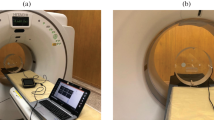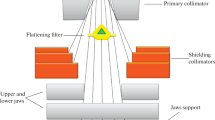Abstract
This work relates to the study and characterization of the CTDI (Computed Tomography Dose Index) for the 16 slices CT scanner. The CTDI has been simulated with the Monte Carlo code GATE for PMMA (polymethylmethacrylate) digital phantoms of various diameters (1–50 cm) at various kVp (80, 110, 130) and mAs (100, 200, 300, 400 mAs) levels. After using a High-Performance Computing (HPC) station, a good agreement was observed (less than 1.18% for head phantom and 1.85% for body phantom for all applied voltages) between simulations and experimental measurements with standard PMMA phantoms. Results of simulations demonstrated the following. Firstly, GATE is an adapted tool to estimate CTDI values and can be used to optimize CT parameters in clinical applications. Secondly, Monte Carlo simulation may be able to estimate the absorbed dose when the CTDI method has limitations (use of homogeneous standards cylindrical phantom, the dose measurement in air not in tissue).












Similar content being viewed by others
REFERENCES
M. O. Bernier, J. L. Rehel, H. J. Brisse, et al., “Radiation exposure from CT in early childhood: A french large-scale multicentre study,” Brit. J. Radiol. 85, 53–60 (2012).
O. W. Linton and F. A. Mettler, “National conference on dose reduction in CT with an emphasis on pediatric patients,” Am. J. Roentgenol. 18, 321–329 (2003).
F. H. B. van Wyk, Th. Mabhengu, M. Di Tamba Vangu, A. K. Kyere, and J. H. Amuasi, “Determination of dose delivery accuracy in CT examinations,” J. Radiat. Res. Appl. Sci. 8, 489–492 (2015).
National Research Council, Health Risks from Exposure to Low Levels of Ionizing Radiation: BEIR VII Phase 2 (Natl. Acad. Press, Washington, DC, 2006).
E. J. Hall and D. J. Brenner, “Cancer risks from diagnostic radiology,” Brit. J. Radiol. 81, 362–378 (2008).
"European guidelines on quality criteria for computed tomography," Report EUR 16262 EN (European Commission, Brussels, Belgium, 1999).
Int. Atomic Energy Agency, “Optimization of the radiological protection of patients undergoing radiography, fluoroscopy and computed tomography,” IAEA-TECDOC-1423 (IAEA, Vienna, 2004).
A. Saravanakumar, K. Vaideki, K. N. Govindarajan, and S. Jayakumar, “Establishment of diagnostic reference levels in computed tomography for select procedures in Pudhuchery, India,” J. Med. Phys. 39, 50–55 (2014).
L. Jangland, E. Sanner, and J. Persliden, “Dose reduction in computed tomography by individualized scan protocols,” Acta Radiol. 45, 301–307 (2004).
J. Peter, M. P. Tornai, and R. J. Jaszczek, “Analytical versus voxelized phantom representation for Monte Carlo simulation in radiological imaging,” IEEE Trans. Med. Imaging 19, 556–564 (2000).
Chang-Lae Lee, Hee-Joung Kim, Yong Hyun Chung, and A.-Ram Yu, “GATE simulations of CTDI for CT dose,” J. Korean Phys. Soc. 54, 1702 (2009).
Am. Assoc. Phys. Med., “The measurement, reporting, and management of radiation dose in CT,” AAPM Report No. 96 (AAPM, 2008).
Am. Assoc. Phys. Med., “Size-specific dose estimates (SSDE) in pediatric and adult body CT examinations,” AAPM Report No. 204 (AAPM, 2011).
Am. Assoc. Phys. Med., “Comprehensive methodology for the evaluation of radiation dose in X-ray computed tomography,” AAPM Report No. 111 (AAPM, 2010).
S. Jan et al., GATE: a simulation toolkit for PET and SPECT," Phys. Med. Biol. 49, 4543–4561 (2004).
S. Jan, D. Benoit, E. Becheva, T. Carlier, F. Cassol, P. Descourt, T. Frisson, L. Grevillot, L. Guigues, L. Maigne, C. Morel, Y. Perrot, N. Rehfeld, D. Sarrut, D. R. Schaart, et al., “GATE V6: A major enhancement of the GATE simulation platform enabling modelling of CT and radiotherapy,” Phys. Med. Biol. 56, 881–901 (2011).
S. Agostinelli et al., “Geant-4 a simulation toolkit,” Nucl. Instrum. Methods Phys. Res., Sect. A 506, 250–303 (2003).
S. Staelens et al., “GATE: Improving the computational efficiency,” Nucl. Instrum. Methods Phys. Res., Sect. A 569, 341–345 (2006).
P. Meyer, E. Buffard, L. Mertz, C. Kennel, A. Constantinesco, and P. Siffert, “Evaluation of the use of six diagnostic X-ray spectra computer codes,” Brit. J. Radiol. 77, 224–230 (2004).
M. Parsi, M. Sohrabi, F. Mianji, and R. Paydar, “GANTRY angulation effects on CT dose along the z‑axis direction in head examinations,” Radiat. Prot. Dosim. 177, 1–8 (2017).
J. Boone, “Method for evaluating bow tie filter angle-dependent attenuation in CT: Theory and simulation results,” Med. Phys. 37, 40–48 (2010).
Y. J. Chen, B. Liu, M. K. O’Connor, C. S. Didier and S. J. Glick, “Comparison of scatter/primary measurements with GATE simulations for X-ray spectra in cone beam CT mammography,” in Proceedings of the IEEE Nuclear Science Symposium Conference (IEEE, 2006), Vol. 6, pp. 3909–3914.
S. P. Raman, M. Mahesh, R. V. Blasko, E. K. Fishman, and C. T. Scan, “Parameters and radiation dose: Practical advice for radiologists,” J. Am. Coll. Radiol. 10, 840–846 (2013).
H. Zhou and J. M. Boone, “Monte Carlo evaluation of CTDI in infinitely long cylinders of water, polyethylene and PMMA with diameters from 10 mm to 500 mm,” Med. Phys. 35, 2424–2431 (2008).
D. E. Carver, S. D. Kost, M. J. Fernald, K. G. Lewis II, N. D. Fraser, D. R. Pickens, R. R. Price, and M. G. Stabin, “Development and validation of a GEANT4 radiation transport code for CT dosimetry,” Health Phys. 108, 419–428 (2015).
P. Papadimitroulas, G. C. Kagadis, A. Ploussi, S. Kordolaimi, D. Papamichail, E. Karavasilis, V. Syrgiamiotis, and G. Loudos, “Pediatric personalized CT-dosimetry Monte Carlo simulations, using computational phantoms,” J. Phys.: Conf. Ser. 637, 012020 (2015).
M. Mkimel et al., “Radiation dose assessement on dual and 16 slices MDCT using Monte Carlo simulation,” in Proceedings of the 2018 IEEE International Symposium on Medical Measurements and Applications, Rome,2018, pp. 1–5.
Author information
Authors and Affiliations
Corresponding author
Rights and permissions
About this article
Cite this article
Mkimel, M., El Baydaoui, R., Mesradi, M.R. et al. Monte Carlo Simulation of the Computed Tomography Dose Index (CTDI) Using GATE. Phys. Part. Nuclei Lett. 17, 900–907 (2020). https://doi.org/10.1134/S1547477120060084
Received:
Revised:
Accepted:
Published:
Issue Date:
DOI: https://doi.org/10.1134/S1547477120060084




